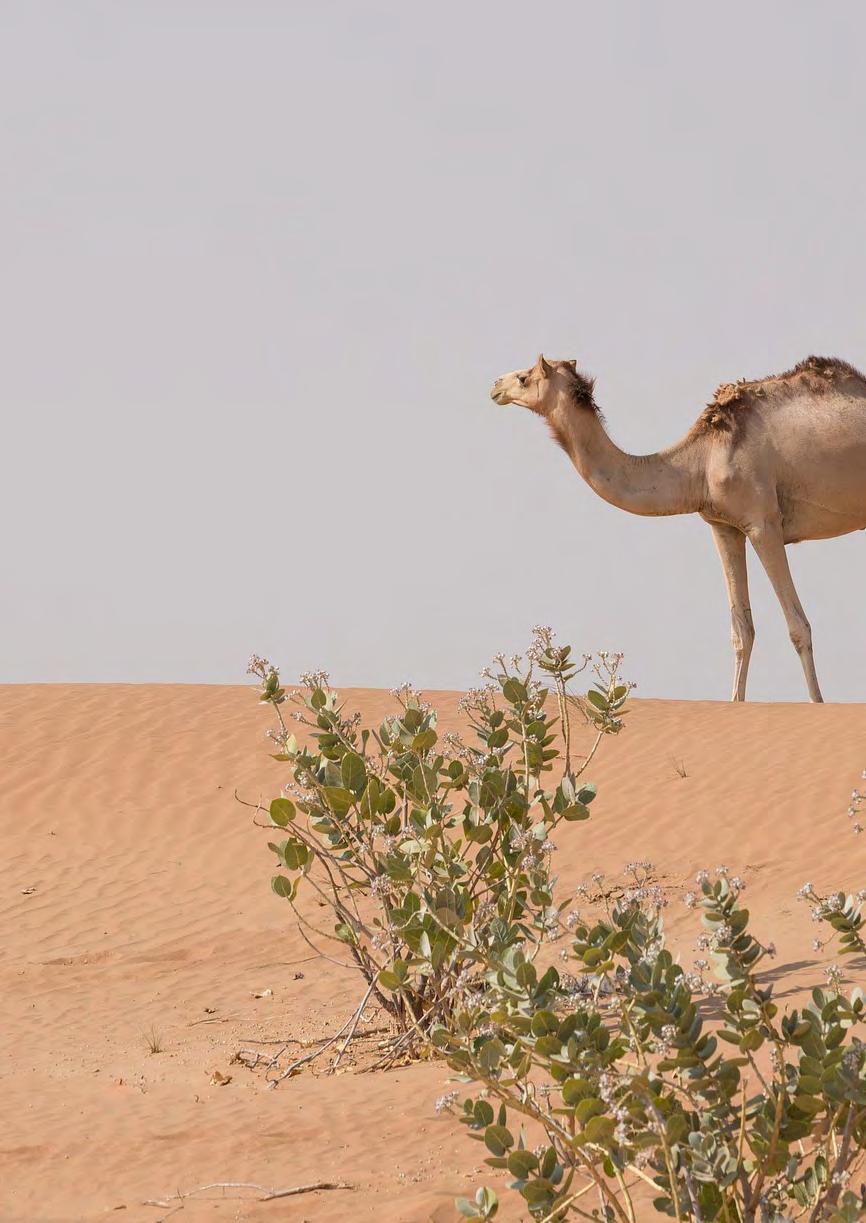

WELCOME
For almost 18 years, SimpliFlying has been a trusted partner to airlines, airports, and technology firms worldwide. We have been on a mission to help build trust in aviation. To empower the industry to soar to new heights through digitalisation, innovation, and a steadfast commitment to sustainability.
We're not just sought after strategy consultants, we are passionate advocates for meaningful change. Headquartered in Singapore, our global team based out of Canada, India, Spain and the UK is dedicated to equipping aviation and technology executives with the tools, insights, and strategies needed to navigate the complexities of sustainable aviation.
From major airlines and airports to aircraft manufacturers and travel technology companies, our extensive client base underscores our reputation as a trusted partner in the aviation industry since 2008.

HOW CAN WE HELP?
At SimpliFlying, we're committed to helping you navigate the complexities of sustainable aviation and thrive in an ever-changing landscape. Here are some ways we can help you in your sustainability journey:
Connect sustainable tech startups with investors and industry
SimpliFlying Immersions pioneer a new era of real-life connections through immersive experiences, deep learning, and cutting-edge innovation exchange. We do this by facilitating site visits and bringing aviation leaders to startup facilities to offer a platform for tangible collaborations to take shape.
Share your vision with a global audience
Like 80+ other CxOs in the industry, enlist your CEO or Head of Sustainability to be interviewed by Shashank Nigam. Share your vision for the future of travel on the world’s best-known sustainable aviation podcast "Sustainability in the Air". Find out more on becoming a partner.
Grow your brand in aviation
SimpliFlying has helped a multitude of technology firms scale up in aviation – from launching an airplane to marketing an Airbus A380 engine. We can help you amplify your brand and help build awareness with key decision-makers.
Stay informed, stay ahead
We deliver in-depth monthly or quarterly briefings to the senior leadership teams on a topic/issue of your choosing. You can also sign up for a series of briefings that cover key aspects of the present and future of sustainable aviation.

EXECUTIVE SUMMARY
The United Arab Emirates (UAE) and the broader Gulf Cooperation Council (GCC) region are emerging as key players in aviation sustainability, demonstrating that environmental responsibility and economic growth are not competing priorities but complementary strategies for the future.
Since hosting COP28 in late 2023, the UAE has accelerated its transformation into a hub for sustainable aviation innovation, combining ambitious policy frameworks with concrete investments across sustainable aviation fuel production (SAF), alternative propulsion systems, airport infrastructure, and climate technology. This report examines the UAE's approach to aviation decarbonisation, showcasing achievements across five critical areas:
• SAF development through innovative feedstock pathways;
• The emergence of electric and hydrogen aircraft operations;
• World-leading airport sustainability initiatives;
• Breakthrough climate technologies, including carbon capture and renewable energy;
• The institutional frameworks established to support long-term transformation.
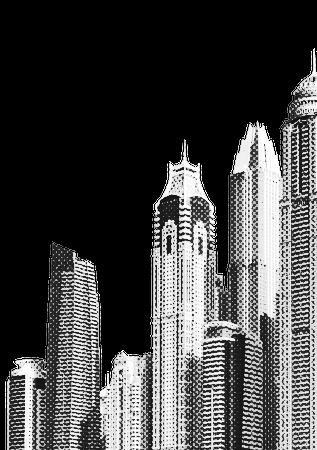
Illustrative milestones show this momentum:
• The UAE's National SAF Roadmap sets a target of 700 million litres of annual production by 2030, positioning the nation as both a regional supplier and global exporter.
• Dubai International Airport has achieved the Airport Carbon Accreditation Standard Level 4 'Transformation' status, placing it among the top 5% of airports worldwide.
• Revolutionary electric vertical takeoff and landing (eVTOL) aircraft are preparing for commercial operations in Dubai by 2026, while partnerships between energy giants and aviation pioneers are accelerating the development of hydrogen-powered aircraft.
Together, these achievements reflect a uniquely positioned region that combines visionary leadership, abundant renewable energy resources, strategic geographic location, and established aviation infrastructure.
As Dubai prepares to host the aviation industry's premier gathering in November 2025, the UAE stands ready to showcase not just ambitious plans, but tangible progress toward a sustainable aviation future that serves as a model for regions worldwide.

AN AMBITIOUS JOURNEY
THE CLIMATE ACTION JOURNEY IN THE ENERGY SECTOR TO REACH NET ZERO BY 2050
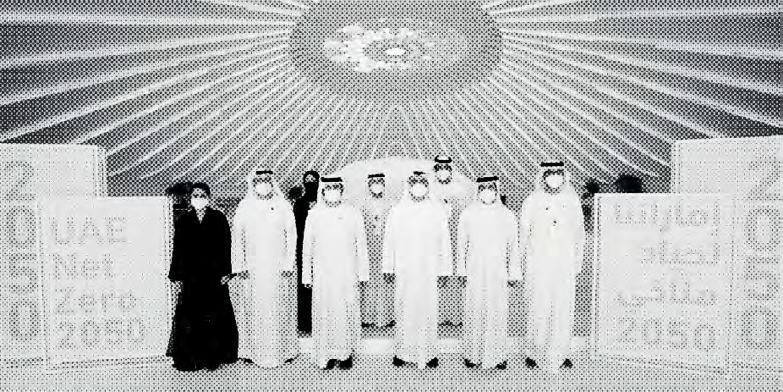
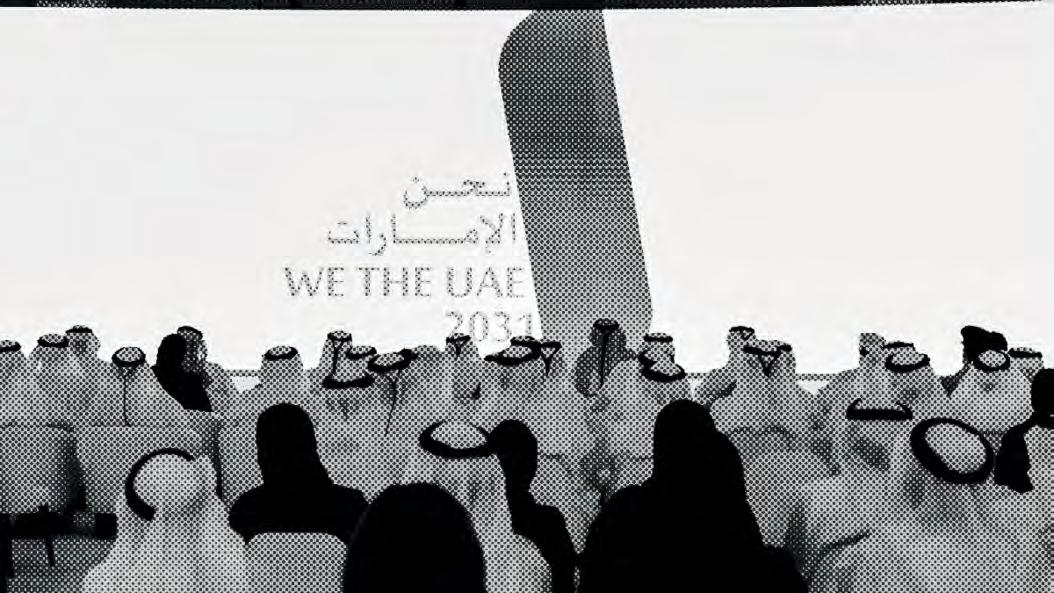

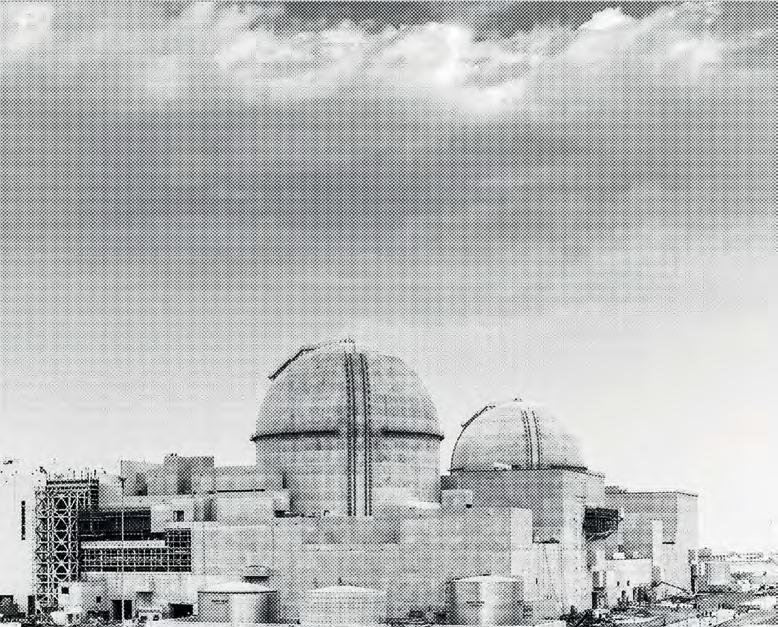



INTRODUCTION: THE UAE'S SUSTAINABILITY TRANSFORMATION
The UAE has for decades been associated with aviation excellence, home to world-leading airlines and airports that have redefined global connectivity, and served as a bridge between East and West, and North and South. Today, the nation is leveraging that same ambition and expertise to pioneer a new chapter: sustainable aviation that balances environmental responsibility with continued growth and economic prosperity.
The decision to host COP28 in Dubai in November-December 2023 marked a pivotal moment for the UAE's climate leadership. This global event, attended by world leaders, catalysed a comprehensive sustainability transformation across the nation's key economic sectors, with aviation among its strategic priorities.
The commitments made during COP28 have since translated into tangible action, with billions of dollars in investment, multiple major projects launched or accelerated, and regulatory frameworks established to support long-term decarbonization.
Why aviation matters for the UAE
Aviation is a cornerstone of the UAE’s economy. Dubai International Airport remains the world's busiest airport for international passengers, while Emirates and Etihad Airways connect six continents through their global networks.
In fact, aviation contributes 18.2% to the national economy, generating around US$92 billion in revenue and supporting nearly one million jobs.
This economic centrality makes aviation decarbonisation both challenging and essential. The UAE cannot simply reduce aviation activity to meet climate goals; instead, it must pioneer technologies and practices that enable continued growth while dramatically reducing carbon intensity.
This impetus has driven innovation across the entire aviation value chain, from fuel production to aircraft operations to ground infrastructure.
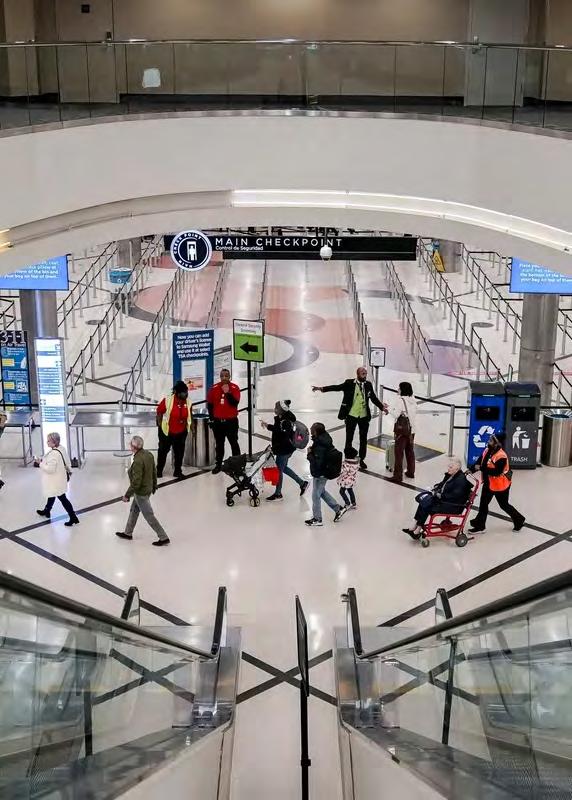
Source:
Elijah Nouvelage / Bloomberg
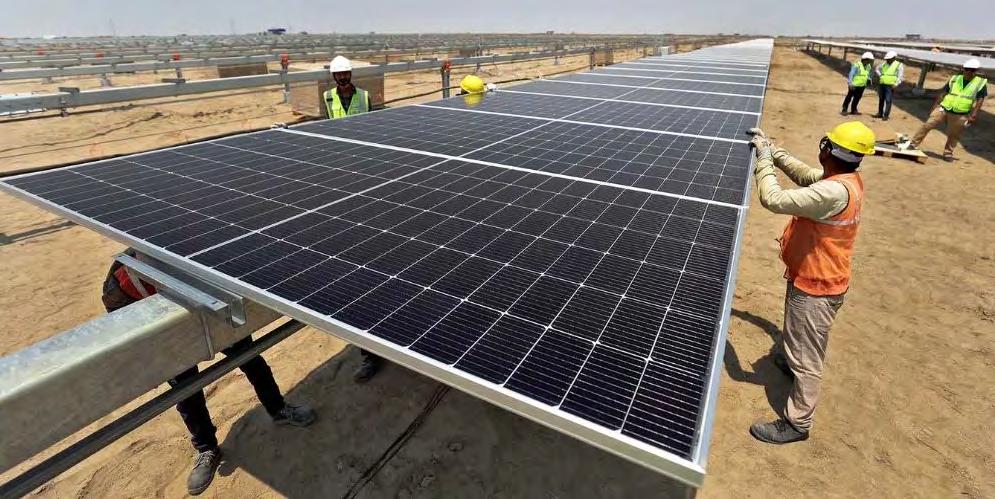
Source: Texas Systems Technology
The GCC advantage
The UAE's leadership extends across the broader GCC region, where similar advantages position the Gulf states as natural leaders in sustainable aviation. The region benefits from abundant solar resources, already one of the lowest costs of solar energy in the world, and more and more UAE businesses are switching to using it. This renewable energy advantage, in turn, forms the foundation for the production of green hydrogen and Power-to-Liquid (PtL) fuels. The strategic geographic location at the crossroads of Europe, Asia, and Africa makes the GCC an ideal hub for both aviation operations and SAF exports to global markets.
Moreover, the region's established energy expertise, traditionally in hydrocarbons, is being strategically redirected toward nextgeneration energy systems. Companies like ADNOC, Masdar, and others are leveraging decades of experience in large-scale energy projects to accelerate the deployment of carbon capture, hydrogen production, and sustainable fuels. This represents not an abandonment of the region's energy heritage, but its evolution for a lowercarbon future.
Dirk Singer Head of Sustainability, SimpliFlying dirk@simpliflying.com

BUILDING A REGIONAL SAF HUB
Baseline scenario concludes that 700ML SAF production is a pragmatic target for the UAE
In 2022, the UAE Ministry of Energy and Infrastructure, in collaboration with the General Civil Aviation Authority, published the National Sustainable Aviation Fuel Roadmap — a comprehensive strategy designed to position the UAE as a regional hub for Sustainable Aviation Fuel (SAF) production and a global leader in sustainable aviation.
The roadmap sets an ambitious yet achievable target of 700 million litres of SAF production annually by 2030, equivalent to around 7.6% of the UAE's 2019 jet fuel consumption.
The economic and environmental benefits are substantial. Those 700 million litres of annual SAF production will cumulatively reduce 4.8 million tonnes of CO2 emissions by 2030 while creating up to 18,000 new jobs across the value chain, from feedstock cultivation and collection through refining, distribution, and quality assurance.
Source: UAE Government
The required investment of $7-9 billion in facilities and supporting infrastructure will be distributed across multiple projects, creating a diversified SAF ecosystem rather than reliance on a single pathway or facility.
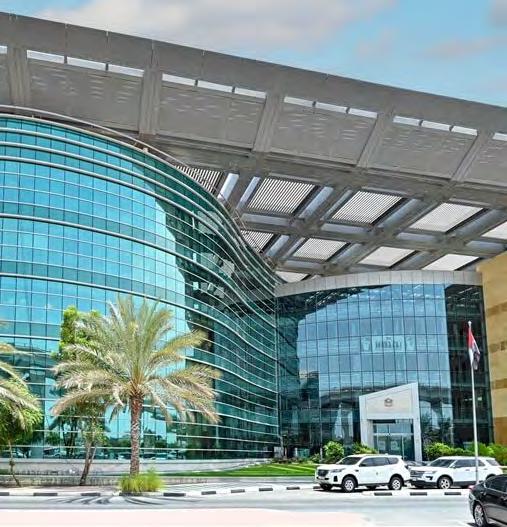
Source: Ministry Of Energy & Infrastructure


Innovative feedstock strategies
The UAE's approach to SAF feedstock development reflects both the opportunities and constraints of the regional environment.
The GCC's arid climate restricts access to some conventional biogenic feedstocks — such as agricultural residues, used cooking oil and animal fats — that are more readily available in temperate regions. Yet rather than treating this as a limitation, the UAE is pioneering alternative feedstock pathways uniquely adapted to desert conditions and aligned with the region’s comparative advantages.
Feedstock assessment showed that halophytes, MSW and non biogenic feedstocks (CO2 & H2) have the highest potential for the UAE to produce SAF
Source: UAE Government
Four pathways to sustainable aviation fuel (SAF)
Halophytes: desert plants as aviation fuel
Halophytes are plants that can survive and grow in saline environments where regular crops cannot. They are especially valuable because they can be irrigated with seawater, which helps conserve freshwater and opens new possibilities for growing bioenergy crops in the desert.
These salt-tolerant plants are now an integral part of the UAE’s SAF strategy, forming the foundation of the Seawater Energy and Agriculture System (SEAS) developed at Khalifa University by the Sustainable Bioenergy Research Consortium (SBRC).
Established in 2011, the SBRC began as a partnership between the Masdar Institute, Etihad Airways, Boeing and Honeywell UOP, later expanding to include Safran, GE, ADNOC Refining and Bauer Resources.
The SEAS model integrates three complementary components:
• Aquaculture, where seafood is farmed using seawater;
• Halophyte agriculture, where oilseed crops capable of tolerating saline conditions (halophytes) are cultivated;
• Halophyte agroforestry, which produces biomaterials.
This combined approach generates several types of products, including oilseeds that can be turned into SAF, making the project economically and environmentally beneficial.
In January 2019, the initiative achieved a landmark milestone when Etihad Airways operated the first commercial flight from Abu Dhabi to Amsterdam, partially powered by SAF refined from Salicornia oilseeds grown at the SEAS facility and processed at the ADNOC Refining Research Center. This flight demonstrated an entirely UAE-based SAF supply chain from cultivation through refining to aircraft operations.
Building on the success of its pilot projects, the SBRC is developing a 200-hectare demonstration site for halophyte cultivation in Abu Dhabi’s western region, with the potential to expand to 100,000 hectares over time. At full scale, this halophyte pathway could produce between 80,000 and 152,000 tonnes of SAF per year by 2033, with room for further growth as the system matures. Crucially, halophyte cultivation relies on land and seawater unsuitable for conventional farming, creating economic value without competing with food production.
Municipal solid waste: urban resources as aviation fuel
A second major pillar of the UAE’s SAF strategy involves the use of municipal solid waste (MSW) as feedstock for SAF production. In November 2021, Abu Dhabi Waste Management Centre (Tadweer) signed a Joint Project Development Agreement with Etihad Airways to develop the Middle East’s first waste-to-SAF facility.
The planned Tadweer plant is designed to process around 4 million tonnes of MSW each year, converting it — through Fischer–Tropsch synthesis technology — into approximately 140 million gallons (about 420,000 tonnes) of SAF. This would make it the largest SAF production facility in the UAE’s roadmap, and a core contributor to the national target of producing 700 million litres by 2030.
Sustainability impact and circular economy
• The Tadweer project is expected to reduce CO₂ emissions by roughly 1 million tonnes per year by diverting large volumes of waste from landfills and reducing methane emissions from decomposition.
• The plant embodies circular economy principles by transforming previously landfilled waste into value-added clean fuel while easing pressure on the Emirates’ limited landfill capacity.
• Because municipal solid waste is continually generated and systematically collected across the UAE’s expanding urban areas, this pathway provides a stable and scalable feedstock source to support future SAF production growth.

Source: Utilities Middle East
Power-to-Liquid: renewable energy as aviation fuel
The third strategic pillar of the UAE’s SAF programme leverages the nation’s world-leading solar resources to produce liquid aviation fuels from renewable electricity. Power-toLiquid (PtL) technology uses renewable energy, typically solar, to electrolyse water into hydrogen, which is then combined with captured CO₂ to synthesise liquid hydrocarbons for SAF production.
The UAE is particularly well positioned for PtL development, with solar power purchase agreements achieving record-low prices — now below 1.5 US cents per kilowatt-hour — making the country one of the most cost-competitive solar energy producers in the world. These ultra-low costs, combined with abundant year-round sunshine, enable the competitive production of energy-intensive fuels such as green hydrogen for PtL conversion.
The UAE National SAF Roadmap also incorporates findings from research conducted by the World Economic Forum (WEF) and ICF, which project that PtL could supply around 180,000 tonnes of SAF annually by 2030, scaling up to 5.08 million tonnes per year by 2050.
Several PtL initiatives are already underway. Masdar and TotalEnergies have announced a partnership to build a commercial-scale PtL facility that will convert green hydrogen into methanol and subsequently into SAF, using captured CO₂ from UAE industrial sources. This collaboration builds on a landmark test flight powered by methanol-derived SAF during COP28 in December 2023, which demonstrated the technical feasibility of PtL pathways for aviation.
The scale and ambition of the UAE’s PtL efforts are unmatched in the region, positioning the nation as a future leader in renewable e-fuels for aviation.
Lootah Biofuels: Pioneering local SAF supply
Beyond large-scale infrastructure projects, smaller initiatives are proving equally important in establishing a complete SAF ecosystem.
Founded in 2010 as the Middle East’s first commercial biofuel producer, Lootah Biofuels announced in September 2025 that it would introduce its SAF offering at the 2025 Dubai Airshow.

Source: Lootah Biofuels
The company has outlined a three-phase roadmap:
• Initially importing SAF to meet immediate demand, supported by local supply collection through an app that enables businesses to dispose of used cooking oil (UCO);
• Establishing a medium-term domestic production facility;
• And ultimately localising full-scale SAF production to enhance energy security, reduce imports and create green jobs.
Lootah has already completed feasibility and engineering studies for a dedicated SAF plant in the UAE while collaborating with international facilities to expand its bio-based product portfolio. Its SAF is produced from used cooking oil and waste-derived fats, in compliance with ASTM D7566-24 and ICAO CORSIA
standards. Compared with conventional jet fuel, it can cut greenhouse gas emissions by up to 80%. The fuel can be blended with Jet A-1 at ratios of up to 50% and delivers cleaner combustion with ultra-low sulphur content.
The company's existing expertise in UCO collection provides a significant advantage. As one of the largest UCO collectors authorised by Dubai Municipality, Lootah Biofuels operates its own fuel outlets across the city and has established collection infrastructure serving restaurants, bakeries, food chains, and households.
Speaking to Aviation Business, Yousif Lootah, CEO of Lootah Biofuels, emphasised the significance:
"As one of the first local suppliers of SAF, we are proud to launch SAF in the UAE market and showcase it at Dubai Airshow to local and international stakeholders and leading companies in the aviation industry. This initiative reflects Lootah Biofuels' commitment to innovation, reinforces our alignment with the UAE's sustainability vision, and brings us closer to our aspirations of collaborating with global aviation partners to accelerate decarbonization."
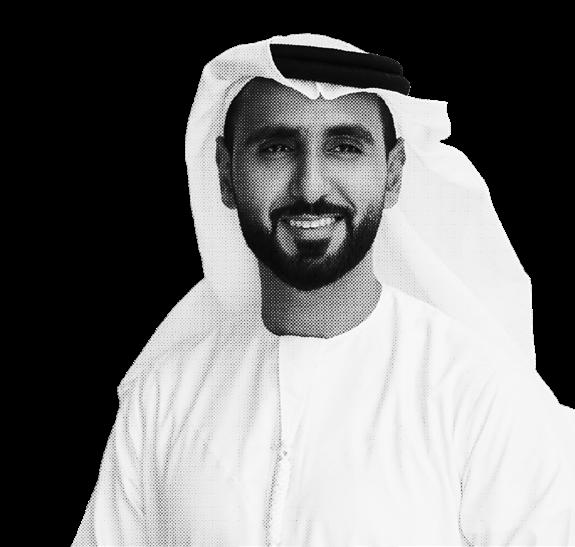
Lootah Biofuels' entry into SAF production demonstrates how biodiesel producers can leverage existing infrastructure, feedstock networks, and technical expertise to enter the aviation fuel market. Its annual production capacity of 60 million litres from three recycling facilities, serving more than 2,500 clients, provides a strong foundation for scaling SAF supply as demand grows.
Economic opportunity through SAF exports
A distinctive element of the UAE's SAF strategy is its explicit focus on export markets alongside domestic consumption.
The National SAF Roadmap anticipates that around half of the 2030 production target could be directed towards export opportunities — particularly to regions with mature policy frameworks such as the European Union — generating an estimated US$1.7 billion in cumulative export revenue by 2030. This export orientation reflects several strategic advantages:
• The UAE’s abundant renewable energy resources and innovative feedstock solutions enable potentially cost-competitive SAF production at a time when global demand is projected to outstrip supply.
• The geographic location between Europe and Asia positions the UAE as a convenient supplier for airlines operating through Gulf hubs.
• SAF exports contribute to the diversification of the UAE’s economy, creating high-value energy exports that complement rather than compete with traditional hydrocarbon production.
The EU's mandate for SAF blending reaching 70% by 2050, creates substantial and predictable demand that exceeds Europe's likely domestic production capacity. Similar mandates are emerging in other jurisdictions, pointing to a rapidly expanding global market in which early-mover advantage and production scale will determine long-term competitiveness.
70% of UAE flights are long haul, therefore SAF has a key role in the UAE's aviation decarbonisation
Source: UAE Government
Industry leadership: Emirates and Etihad
The UAE's national carriers have emerged as champions of SAF, driving both demandside uptake and supply-side innovation.
In May 2023, Emirates announced a $200 million Aviation Sustainability Fund dedicated to research and development projects aimed at reducing the fossil fuel impact of commercial aviation. This represents one of the largest airline-funded sustainability initiatives worldwide.
Emirates has also undertaken extensive SAF testing, including flights powered by 100% SAF in partnership with GE Aviation on its Boeing 777-300ER aircraft equipped with GE90 engines. Currently, SAF is certified for use at blends of up to 50% with conventional jet fuel, but
Emirates’ testing supports international efforts to develop specifications that would enable 100% SAF operations — a step that could significantly accelerate aviation decarbonisation.
Etihad Airways has been equally ambitious, signing the Joint Project Development Agreement with Tadweer for the MSWto-SAF facility and collaborating with Lufthansa Group and Masdar on green hydrogen applications for aviation. These partnerships demonstrate how UAE-based airlines are using their market position to catalyse supply chain innovation.
ALTERNATIVE PROPULSION SYSTEMS

Electric aviation
While SAF addresses emissions from existing aircraft, alternative propulsion systems promise zero-emission flight for shorter ranges and urban mobility. The UAE has positioned itself at the forefront of this emerging sector — particularly in the development of electric vertical take-off and landing (eVTOL) aircraft, which are set to redefine urban and regional transport.
Joby Aviation
Dubai’s most advanced eVTOL initiative centres on Joby Aviation’s partnership with Dubai’s Roads and Transport Authority (RTA). In 2024, the RTA and Joby signed a six-year agreement granting Joby exclusive rights to operate air taxi services in Dubai — a landmark deal that positions the emirate as likely the first city globally to launch commercial eVTOL operations at scale.
Joby’s S4 aircraft is a five-seat eVTOL (one pilot, four passengers) powered by lithium-ion batteries that drive six electric propellers. These tilt to enable both vertical take-off and efficient wingborne cruise flight at around 174 knots (200 mph). The aircraft produces zero emissions in operation and generates far less noise than helicopters, addressing two key barriers to urban air mobility adoption.
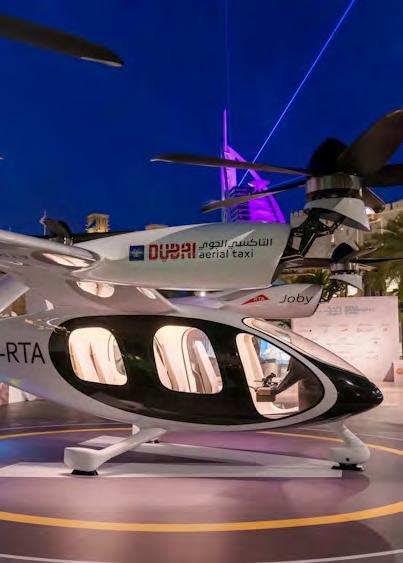
Source: Joby Aviation
In July 2025, Joby delivered its first S4 aircraft to the UAE and completed multiple piloted transition flights — the crucial manoeuvre from vertical hover to horizontal cruise — demonstrating operational readiness in the region’s demanding desert conditions.
The planned Dubai network will connect Dubai International Airport with Downtown Dubai, Dubai Marina, and Palm Jumeirah. Travel times will be transformative: a journey from Dubai International to Palm Jumeirah that currently takes 45 minutes by car will take roughly 12 minutes by air taxi — a major advantage for business travellers, tourists and residents seeking to avoid ground congestion.
Infrastructure development is advancing alongside certification. Joby broke ground on its first UAE vertiport at Dubai International Airport in November 2024 and is partnering with Skyports to develop additional facilities across the city. Four vertiports are planned initially, with integration into Dubai's metro stations and major roads to enable seamless multimodal journeys. In December 2024, Joby also partnered with Jetex to install electric charging infrastructure at terminals in Dubai and Abu Dhabi.
The RTA projects that commercial passenger-carrying operations will commence in 2026 — slightly later than the original 2025 target — but allowing for rigorous safety validation and regulatory approval. Joby is pursuing air operator certification from the UAE's General Civil Aviation Authority (GCAA), building on its existing FAA Part 135 air carrier certification in the United States.
Archer Aviation
Expanding the UAE’s eVTOL landscape, Archer Aviation is advancing deployment of its Midnight aircraft — a piloted, four-passenger eVTOL specifically designed for urban air mobility and short inter-city routes of around 30 to 50 kilometres.
Abu Dhabi test flights conducted by the company focused on gathering real-world performance data under the region's challenging summer conditions: extreme heat exceeding 45°C, high humidity, and persistent exposure to desert dust.
Adam Goldstein, CEO and Founder of Archer Aviation, said :
“Our initial test flight operations in the UAE represent a critical milestone as we prepare for our commercial deployment in Abu Dhabi. Testing our aircraft in actual operating conditions in the middle of summer provides us with the data we need to progress our commercial and certification efforts both in the UAE and the US.”
Archer has secured Abu Dhabi Aviation (ADA) as its first regional customer, with an initial fleet deployment planned for late 2025. The company is also expanding its UAE operations to include pilot training (in partnership with Etihad Airways), maintenance and repair operations setup, and continued flight testing under the oversight of the GCAA.
Infrastructure work is already advancing. In April 2025, Archer received approval to convert the Abu Dhabi Cruise Terminal helipad into a hybrid heliport

capable of handling both helicopters and eVTOL aircraft. In partnership with Falcon Aviation Services, the company is also developing a vertiport network linking Dubai and Abu Dhabi, leveraging the emirate’s more than 70 existing helipads to enable cross-emirate air taxi operations without major new construction.

Source: Odys Aviation
Odys Aviation
While Joby and Archer focuses on urban air mobility, Odys Aviation is developing hybrid-electric VTOL aircraft designed for both short "air taxi" routes and regional distances of up to 1,200 kilometres. In 2023, the company joined the UAE Ministry of Economy and Tourism’s NextGen FDI programme, which provides market-entry fundamentals for pioneering businesses in high-potential sectors.
Odys aircraft combine electric propulsion for take-off and landing with hybridelectric systems for cruise flight, enabling all-electric operation for up to 320 kilometres and extended range through hybrid power. This configuration could reduce carbon emissions from regional air travel across the GCC by as much as 76% compared with conventional aircraft, while providing zero-carbon flight for all routes within the UAE.
The California-based company plans to establish a regional headquarters in Abu Dhabi, including a large-scale assembly and maintenance facility. This investment is expected to create more than 2,000 direct and indirect jobs and position the UAE as a manufacturing hub for next-generation aircraft. The first UAE-assembled model will carry the 'Made in the UAE' certification, symbolising the country’s evolution from an aviation operator to a technology producer.
His Excellency Dr Thani bin Ahmed Al Zeyoudi , Minister of State for Foreign Trade, emphasised the project’s strategic importance :
“We see significant opportunities for the operation of Odys aircraft across the UAE in civilian, cargo and civil defence activities, and we look forward to developing a new sustainable, low-carbon aviation sector — from clean energy air travel through to advanced manufacturing and research and development capabilities.”
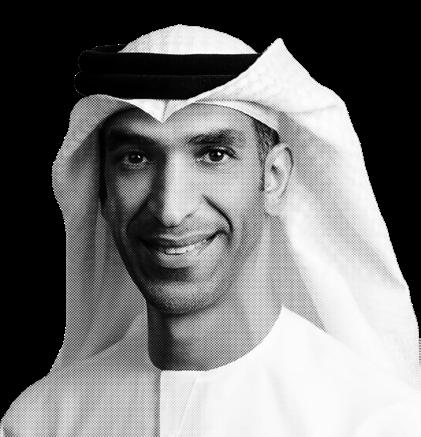
Odys Aviation plans to launch a full-scale prototype in 2025, with commercial entry into service expected in 2027.
Regulatory leadership: GCAA and SAVI
The UAE’s General Civil Aviation Authority has been proactive in developing regulatory frameworks for advanced air mobility, participating in international working groups and establishing domestic certification pathways for eVTOL operations. Both Dubai and Abu Dhabi have launched Sustainable and Autonomous Vehicle Industry (SAVI) clusters that provide regulatory sandboxes for testing and validation.
Hydrogen aviation
These initiatives balance safety assurance with regulatory agility that enables innovation while maintaining public confidence. By working directly with manufacturers such as Joby, Archer and Odys, the GCAA is building institutional expertise that will support the broader industry and position the UAE as a preferred market for introducing next-generation aircraft.
Electric propulsion excels for short-range and urban applications, but the energy density limitations of current battery technology make it less suitable for long-range commercial aviation until battery technology improves drastically. Hydrogen, whether combusted directly in modified turbines or used in fuel cells, offers a pathway to zero-emission flight at scales ranging from regional turboprops to potentially long-range jets.
In August 2023, ZeroAvia, a leading hydrogen-electric engine aircraft developer, signed a partnership agreement with Masdar, the Abu Dhabi-based renewable energy company. ZeroAvia-Masdar partnership
The two organisations are exploring opportunities to develop hydrogen supply ecosystems, beginning in Europe and the United States before expanding to the UAE. ZeroAvia is developing and testing hydrogen-fed fuel cell powertrains for aircraft and working across the hydrogen supply chain to support the rollout of hydrogen-powered aviation.
The partnership with Masdar is strategically significant because it links an aircraft technology pioneer with an organisation aiming to produce one million tonnes of green hydrogen annually,
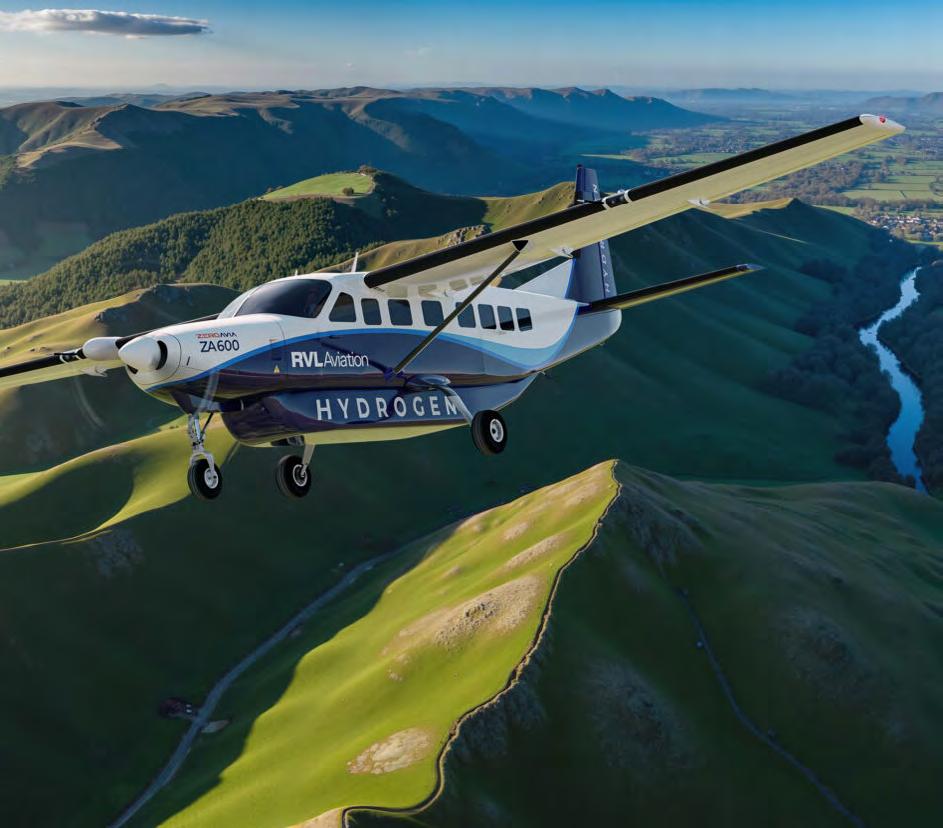
Source: ZeroAvia
positioning Masdar as a global leader in this emerging market.
The collaboration will explore the production, storage and distribution infrastructure required for hydrogen aviation operations. Unlike SAF, which is a drop-in fuel compatible with existing aircraft and refuelling systems, hydrogen requires purposebuilt storage systems, specialised refuelling equipment and modified or entirely new aircraft designs. Early establishment of this infrastructure in the UAE could provide a competitive advantage as hydrogen technologies mature.
Green Hydrogen Alliance
Beyond aviation-specific applications, the UAE has established a comprehensive green hydrogen strategy.
Green hydrogen, produced via electrolysis powered by renewable energy, is preferred for zero-lifecycle emission use cases, while blue hydrogen, produced by ADNOC through steam methane reforming and paired with carbon capture and storage (CCS), serves as a lower-carbon transitional solution utilising existing infrastructure and expertise.
In 2021, Mubadala Investment Company, ADNOC, and Abu Dhabi Developmental Holding Company (ADQ) formed the Abu Dhabi Hydrogen Alliance to accelerate the development and export of both green and blue hydrogen. The Alliance’s roadmap includes international partnerships and aims to make Abu Dhabi a trusted global supplier of low-carbon hydrogen.

Source: Media Office - Abu Dhabi
Hydrogen production infrastructure is advancing through joint ventures with global energy and technology partners. Siemens Energy, in collaboration with DEWA and Masdar, developed the region’s first industrial-scale solardriven green hydrogen plant at Dubai’s Expo 2020 site. Masdar is also trialling solar-powered hydrogen production and evaluating large-scale export opportunities to Europe, where demand for green hydrogen is projected to far exceed domestic supply.
By integrating hydrogen production, carbon capture and fuel synthesis, the UAE is building an ecosystem in which these technologies are complementary and mutually reinforcing — advancing both national energy goals and the decarbonisation of aviation.
AIRPORT AND AIRLINE SUSTAINABILITY LEADERSHIP
From Dubai to Sharjah, the UAE’s airports are redefining what sustainability means in large-scale aviation operations. In one of the world’s most demanding climates, they are proving that efficiency, resilience and environmental responsibility can advance in parallel — positioning the UAE as a model for integrating sustainability into the heart of airport management and design.
Dubai Airports
Dubai Airports operates two major facilities — Dubai International Airport (DXB), consistently the world’s busiest for international passengers, and Al Maktoum International Airport at Dubai World Central (DWC), which is undergoing major expansion. Both airports have become testbeds for integrating environmental responsibility into hightraffic operations, demonstrating that sustainability and performance are complementary rather than competing objectives.
Level
4 ‘Transformation’ accreditation
In September 2024, Dubai International Airport achieved Level 4
‘Transformation’ accreditation under the Airports Council International's (ACI) Airport Carbon Accreditation (ACA) programme. This designation places DXB among the top 5% of accredited airports worldwide and marks it as the first in the UAE to reach this elite level.
The ACA programme is the only globally recognised carbon management standard designed specifically for airports. It provides a structured pathway from initial carbon footprinting through emission reductions to ultimate netzero achievement by 2050. Level 4 accreditation requires not only direct emission reductions but also ecosystemwide transformation — engaging airlines, ground handlers, concessionaires and other stakeholders in collective decarbonisation.
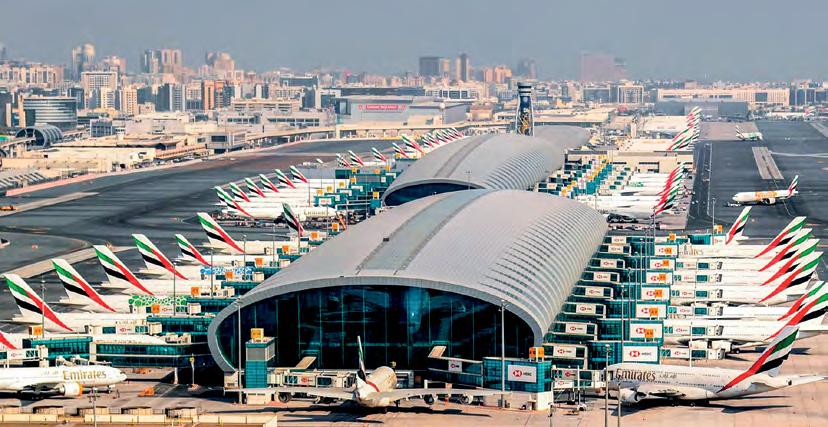
Paul Griffiths , CEO of Dubai Airports, emphasised the significance:
“Achieving Level 4 ‘Transformation’ status validates our holistic approach to sustainability and underscores our commitment to leading the global aviation industry toward a net-zero future. DXB has made significant progress through key initiatives and partnerships aimed at advancing sustainable aviation. Our approach aligns with our industry’s collective vision of achieving net zero emissions by 2050.”

World’s largest airport rooftop solar installation
In October 2024, Dubai Airports launched the world’s largest airport rooftop solar installation, developed in partnership with Etihad Energy Services. The project comprises 62,904 solar panels installed across both Dubai International and Al Maktoum International airports.
At DXB, the system will meet around 6.5% of total energy demand, while at DWC it will supply 20%. As DWC expands towards its ultimate capacity of 260 million passengers annually — five times DXB’s current capacity — this renewable infrastructure will scale proportionally, ensuring that sustainable energy is embedded in the airport's growth trajectory.
Beyond cutting emissions, the solar installation delivers clear economic advantages through lower energy costs and reduced reliance on grid electricity, which in Dubai's desert climate requires significant cooling loads year-round.
Building efficiency and waste management
Complementing its renewable energy investments, DXB has implemented wide-ranging energy efficiency upgrades and circular economy measures:
• LED lighting has been installed throughout terminals, while intelligent building management systems optimise heating, ventilation and air conditioning (HVAC) based on occupancy and ambient conditions. These seemingly routine improvements deliver substantial cumulative carbon savings.
• In partnership with BEE’AH Group, DXB implemented a food waste treatment programme that reduces landfill disposal by 60%. Food waste from restaurants and lounges is collected, processed and converted into useful by-products, avoiding methane emissions from decomposition.

Source: Dubai Airports
Ground operations decarbonisation
On the airside, the airport has pursued systematic decarbonisation of ground operations — a historically diesel-intensive domain. In partnership with dnata (Dubai National Air Transport Association) and Emirates National Oil Company (ENOC), DXB transitioned dnata’s non-electric airside fleet to a biodiesel blend, reducing CO₂ emissions by more than 3,500 tonnes annually.
DXB’s Follow the Greens system further optimises aircraft taxiing routes and speeds, reducing fuel burn and emissions during ground operations. By providing pilots with real-time, optimised taxi guidance, the system minimises engine run time while maintaining operational efficiency — a clear win for both environmental and economic performance.

Source: Ground Handling International
OneDXB Sustainability Alliance
Recognising that meaningful carbon reduction requires ecosystem-wide collaboration, Dubai Airports established the OneDXB Sustainability Alliance — a collaborative network of airlines, ground handlers, concessionaires, government agencies and service providers.
The alliance is exploring more than 180 potential decarbonisation projects across airport operations. By bringing diverse stakeholders together under shared
targets and transparent measurement frameworks, the initiative creates accountability and enables coordinated action in areas where no single operator can achieve transformation alone.
Building for the future
While DXB demonstrates how sustainability can be retrofitted into existing infrastructure, the expansion of DWC offers the opportunity to design for sustainability from inception.
Announced in 2024 , the AED 128 billion (US$34.8 billion) expansion will make DWC the world’s largest airport, with capacity for 260 million passengers and 400 aircraft gates. The massive project is being developed with sustainability embedded in every design element — from renewable energy systems and efficient building materials to integrated waste management and carbon-neutral operations.
Rather than adapting legacy infrastructure, DWC is being conceived as a living laboratory for sustainable aviation infrastructure — demonstrating what can be achieved when decarbonisation is a design principle rather than an afterthought.
Abu Dhabi Airport
Beyond Dubai, Abu Dhabi has taken a complementary approach with Zayed International Airport, where the new terminal was opened as a purpose-built sustainability showcase.
Spanning 480,000 square metres of meticulously crafted green spaces, the terminal integrates drought-resistant plants, efficient irrigation and advanced water management systems, creating a comfortable passenger environment while minimising resource consumption.
The airport earned a 3 Pearl Estidama certification, the UAE’s national sustainability rating that evaluates buildings across design, construction and operational performance. Zayed International is among the largest buildings in the country to achieve this distinction.
Sharjah Airport
Sharjah International Airport has maintained carbon-neutral accreditation under ACI’s Airport Carbon Accreditation programme, implementing integrated strategies for energy efficiency, renewable energy adoption and sustainability-driven policies.
Although smaller in scale than Dubai and Abu Dhabi airports, Sharjah’s achievement demonstrates that meaningful sustainability leadership is attainable for airports of all sizes — and that the drive toward carbon neutrality is shared across the UAE’s entire aviation ecosystem.
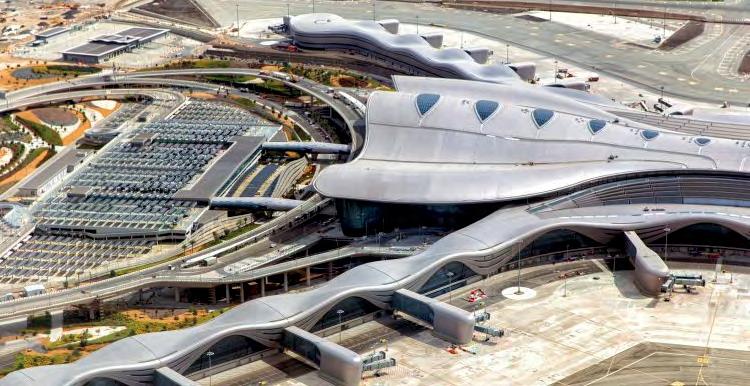
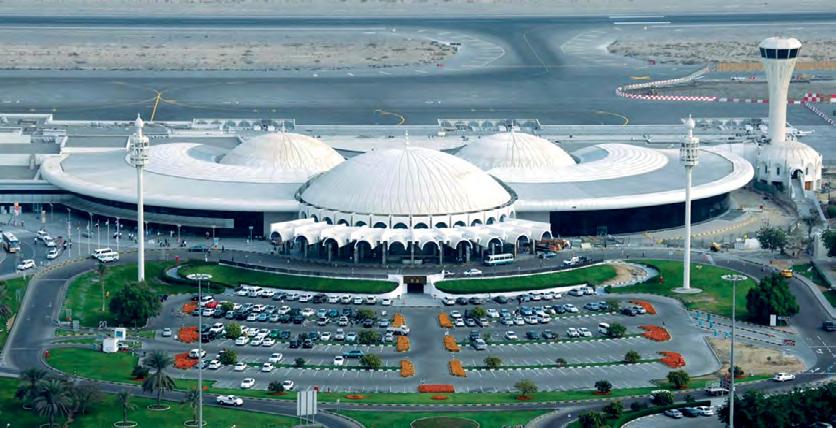
CLIMATE TECHNOLOGY AND ENERGY INNOVATION
The UAE is building one of the world’s most comprehensive clean-energy ecosystems. From carbon capture to renewables and nuclear power, the nation is combining technological ambition with practical delivery, creating a foundation for aviation’s transition to net zero.
Four pillars driving the transition to net-zero flight
Carbon management and removal technologies
The UAE has become a global pioneer in capture, utilisation and storage (CCUS), a critical pillar of its wider net-zero strategy. The nation benefits from suitable geological formations for CO₂ storage, extensive oil-and-gas infrastructure that can be repurposed for capture and transport, and proven technical expertise in large-scale engineering.
For aviation, CCUS and broader carbon removal (CDR) approaches are increasingly relevant for two reasons: captured CO₂ is a key feedstock for e-fuel production, while verified CCUS offer airlines a more credible pathway for addressing residual emissions than carbon offsets.
ADNOC’s carbon capture portfolio
In October 2023, ADNOC and Occidental announced a joint preliminary engineering study to construct the first megatonne-scale direct air capture (DAC) facility outside the United States. Unlike traditional point-source carbon capture, DAC removes CO₂ directly from the atmosphere, enabling net-negative emissions when paired with permanent geological storage.
The proposed plant will capture around one million tonnes of CO₂ a year and feed it into ADNOC’s carbon pipeline network for permanent storage in deep saline aquifers not used for oil and gas production.
At the same time, ADNOC is testing the world’s first fully sequestered CO₂ injection well in a carbonate saline aquifer in Abu Dhabi. This project addresses uncertainties that have slowed the rollout of CCUS globally by providing proven models for replication in similar geological formations worldwide.
A complementary point-source project at Habshan, capturing up to 1.5 million tonnes of CO₂ annually from natural gas processing, further strengthens this portfolio. It represents one of the largest carbon capture initiatives in the MENA region and a major step in integrating CCUS across ADNOC’s existing operations.
Together, these initiatives integrate carbon management directly into energy production and position the UAE as a lower-carbon supplier in global markets that are beginning to value carbon intensity as a procurement criterion.

Source: ADNOC
Project Hajar and the XPRIZE recognition
The UAE’s DAC ambitions gained international recognition when Project Hajar was named a top winner in the XPRIZE Carbon Removal competition, funded by the Musk Foundation. The competition challenged more than 1,300 teams globally to create solutions capable of removing gigatonne-scale CO2 from the atmosphere.
Developed by Aircapture in partnership with 44.01 , Project Hajar integrates modular DAC units with permanent carbon mineralisation in the UAE’s geological formations — turning captured CO₂ into stable rock.

Source: 44.01
The technology has already been demonstrated in both Oman and the UAE, and startup 44.01 is now preparing to scale its mineralisation process globally. Backed by ADNOC and the Fujairah Natural Resources Corporation, the project benefits from institutional support that strengthens its path from pilot to commercial deployment.
Renewable energy transformation
Solar power
While carbon capture tackles existing emissions, the UAE is simultaneously expanding renewables to phase out fossil-fuel electricity generation. And when it comes to solar, the Mohammed bin Rashid Al Maktoum Solar Park stands as one of the world's largest solar facilities, with a capacity exceeding 5 GW, generating clean energy for millions of homes while substantially reducing the UAE's reliance on fossil fuels for electricity generation.
Its vast scale has driven solar costs to record lows, transforming the economics of energy-intensive processes such as hydrogen electrolysis and PtL fuel synthesis.
Where such technologies were once prohibitively expensive, ultra-low-cost renewable electricity now makes them commercially viable — especially for aviation, which depends on liquid fuels.
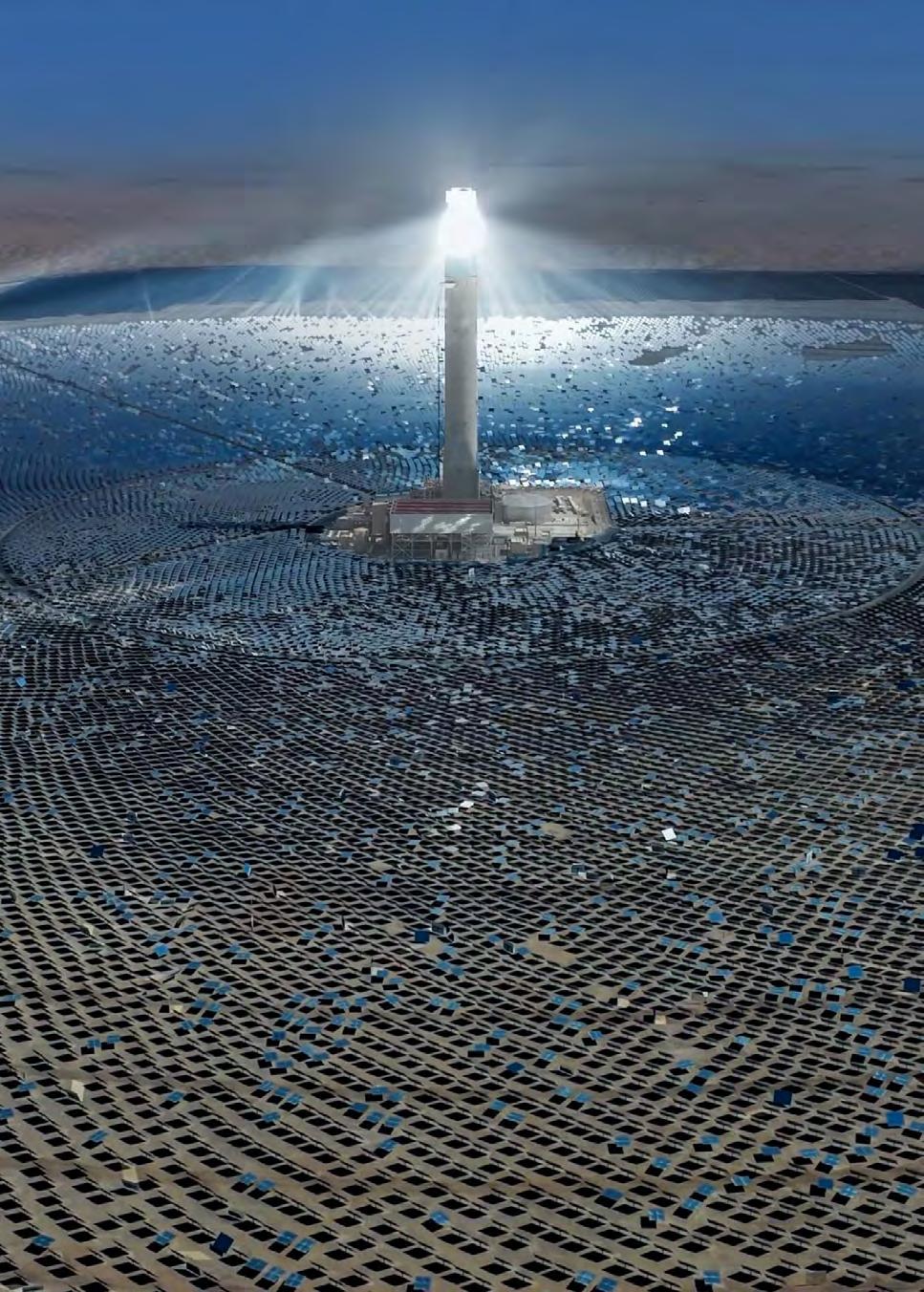
Masdar: clean energy leadership
Masdar, established in 2006 as Abu Dhabi's renewable energy flagship, has evolved into a global clean energy powerhouse with projects spanning multiple continents. The company's mandate calls for expansion to 100 gigawatts of renewable energy capacity by 2030, positioning it among the world's largest renewable energy developers.
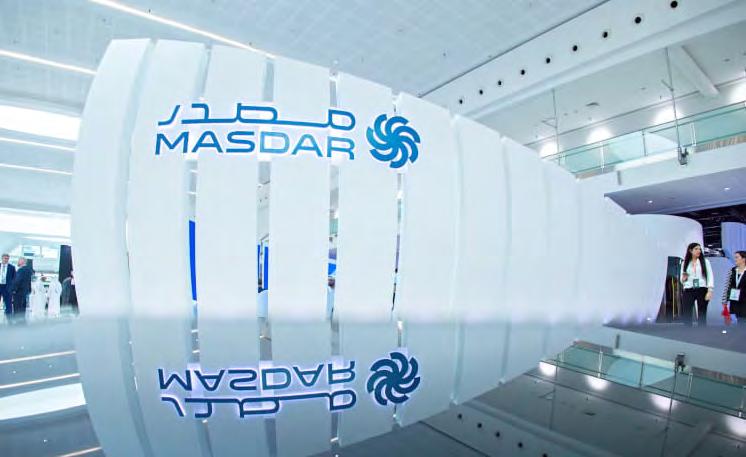
Source: Masdar
Source: Sustainability & Innovation Centre
Wind energy
While solar power remains the dominant source in the UAE’s renewable energy mix, wind energy is emerging as a strategic complement.
In October 2023, the UAE inaugurated its first utility-scale wind power programme, adding 103.5 MW of capacity across four coastal and island sites: Sir Bani Yas Island, Delma Island, Al Sila (Abu Dhabi), and Al Halah (Fujairah). The project will power more than 23,000 homes and reduce around 120,000 tonnes of CO₂ emissions each year.
Beyond these onshore sites, offshore wind potential in the Arabian Gulf is now being assessed. Feasibility studies
have identified promising areas near Delma Island, where stronger and more consistent maritime winds could complement solar energy daytime peak production.
AI-driven optimisation systems are being deployed to analyse real-time wind data and dynamically adjust turbine blade angles, increasing energy yield and supporting predictive maintenance. These advanced systems also help forecast production, improve grid stability, and schedule predictive maintenance, thus making both wind and solar power more reliable and manageable as the UAE expands renewable capacity.

Nuclear energy and the future of clean power
Nuclear power is emerging as a crucial part of the UAE’s clean energy mix — and a potential enabler for sustainable aviation fuels.
Sir Tim Clark, President of Emirates, has been one of aviation’s most vocal advocates for nuclear energy as an essential component of decarbonisation. His argument is clear: producing sustainable aviation fuels at scale requires vast amounts of clean, reliable baseload electricity that intermittent renewables alone cannot provide.
Sir Tim Clark, President of Emirates, has highlighted its relevance to aviation:
“Nuclear will not only give you the power you need for a country but also give you the power to do all these power-to-liquid transformations.”
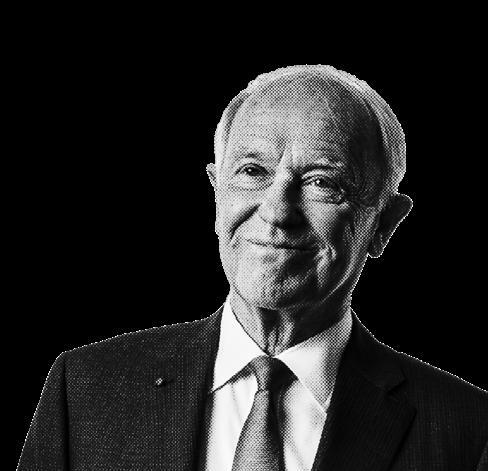
Source: PR Newswire

Source: Construction Week
Small modular reactors (SMR)
The UAE has delivered one of the world’s most successful new nuclear programmes. The Barakah Nuclear Energy Plant in Abu Dhabi now generates around 40 terawatt hours (TWh) of electricity annually, preventing 22.4 million tonnes of carbon emissions — equivalent to removing 4.6 million cars from the road each year.
Building on Barakah’s success, the UAE is already exploring next-generation nuclear technologies that could further extend its clean energy leadership.
In May 2025, the Emirates Nuclear Energy Corporation (ENEC) and GE Vernova Hitachi Nuclear Energy signed a Memorandum of Understanding to evaluate international deployment of the BWRX-300 small modular reactor (SMR) technology.
The BWRX-300, one of the most advanced SMR designs globally, offers several advantages for large-scale clean fuel production:
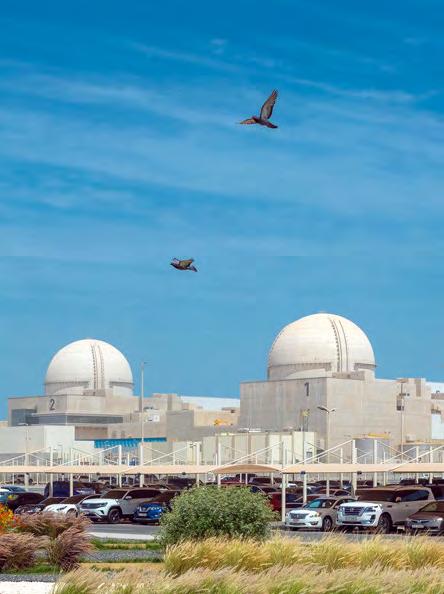
Source: ENEC
• Modularity and scalability: SMRs can be deployed incrementally to meet growing hydrogen and SAF demand;
• Proven design basis: The BWRX-300 builds on decades of boiling water reactor experience, with the first units under construction in Canada and the United States;
• Deployment expertise: The UAE brings extensive experience in licensing, safety regulation, and programme delivery, developed through the successful Barakah project.
The MoU outlines a joint roadmap for potential deployment, including site identification, licensing pathways, investment strategies and supply chain development — the same disciplined approach that made Barakah a model for nuclear project execution.
Linking nuclear power and aviation
For aviation, nuclear energy could play an increasingly important role in enabling large-scale fuel production and deep decarbonisation. It offers three key advantages:
• Continuous hydrogen production: Unlike solar-powered electrolysis, which operates only during daylight hours, nuclear-powered facilities can produce hydrogen around the clock, significantly improving efficiency and output.
• Process heat applications: Advanced reactors can provide high-temperature heat directly for industrial processes such as fuel synthesis, enhancing overall system efficiency.
• Grid stability: Baseload nuclear power ensures that energy intensive SAF plants can operate continuously, maximising capital utilisation and reducing production costs.

Source: ENEC
Barakah’s clean electricity has already enabled a notable milestone: in August 2025, aluminium produced using nuclear power was exported from the UAE for the first time, setting a benchmark for low-carbon heavy industry — and hinting at similar potential for sustainable fuel production.
THE ROAD TO DUBAI AIR SHOW 2025 AND BEYOND
The Dubai Air Show in November 2025 will serve as a pivotal showcase for the UAE’s sustainability achievements and ambitions in aviation. With thousands of industry professionals, investors, policymakers, and media in attendance, the event will spotlight progress, launch new initiatives, and catalyse partnerships across the sector.
Expected highlights include:
• Further details and plans of Joby’s and Archer’s eVTOL aircraft: Concrete signals that electric aviation is moving from concept to market-ready technology.
• Major announcements on SAF production: Possible final investment decisions for PtL plants and nextgeneration biofuels. Already, local biofuels producer Lootah has signalled a SAF announcement in tandem with the airshow.
• Partnerships with global aviation firms: UAE entities will likely announce new agreements to accelerate technology development, deployment, and supply chain integration.
• Regulatory milestones: Updates on eVTOL type certification and the first commercial 100% SAF flight operations.
• Investment commitments: Announcements from private equity, venture capital and sovereign funds supporting UAE-led green aviation ventures.
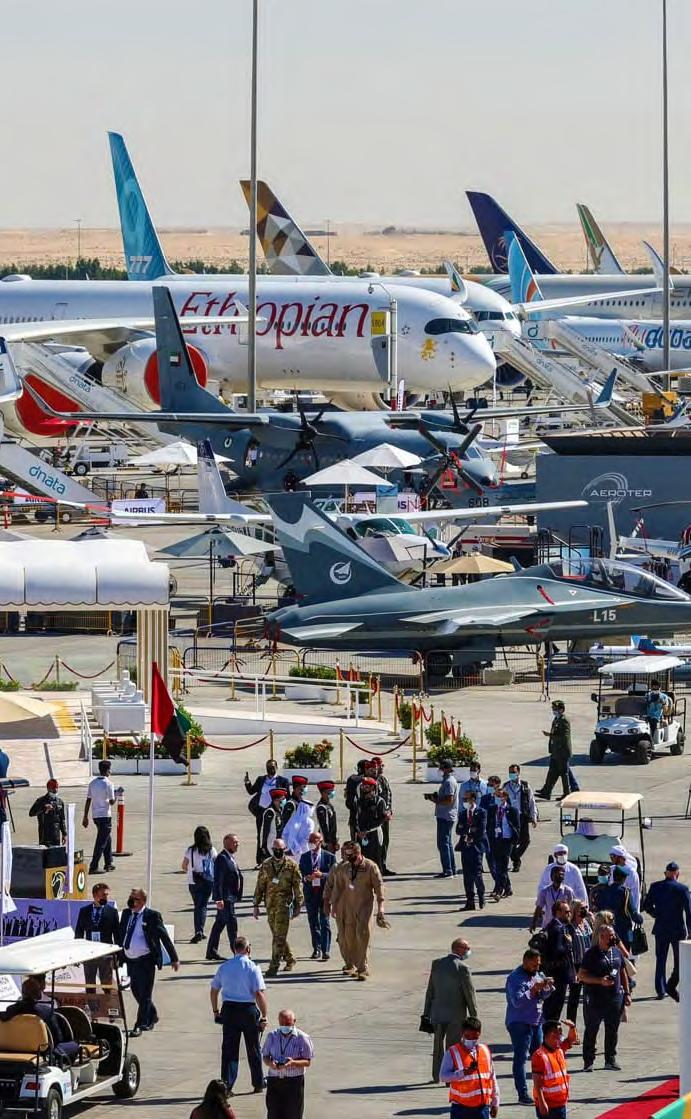
Source: Goverment of Dubai Media Office
Beyond spotlighting achievements, Dubai Air Show 2025 will convene technical working groups, operational forums, and climate finance roundtables, accelerating progress on shared industry barriers.
Investment opportunities
Transitioning aviation to net zero will require large-scale capital mobilisation. The UAE’s National SAF Roadmap estimates between US$7–9 billion in investment by 2030 for production facilities and infrastructure — signalling significant opportunities for investors across sovereign funds, private equity, project finance and green bonds.
Key attractions for investors in the UAE's sustainable aviation include:
• Policy certainty: Robust national strategies and regulatory frameworks.
• Feedstock advantages: Abundant renewable energy, innovative waste-to-fuel, and biogenic resources.
• Strategic location: Enabling exports to Europe and Asia, as well as strong domestic demand.
• Established aviation sector: Immediate market for sustainable fuels and new propulsion technologies.
• Government support: Initiatives like NextGen FDI, innovation funds, and targeted infrastructure investments.
The UAE’s political stability, businessfriendly climate, and demonstrated commitment to sustainability position it as a preferred destination for climate technology capital in emerging markets.
Economic diversification
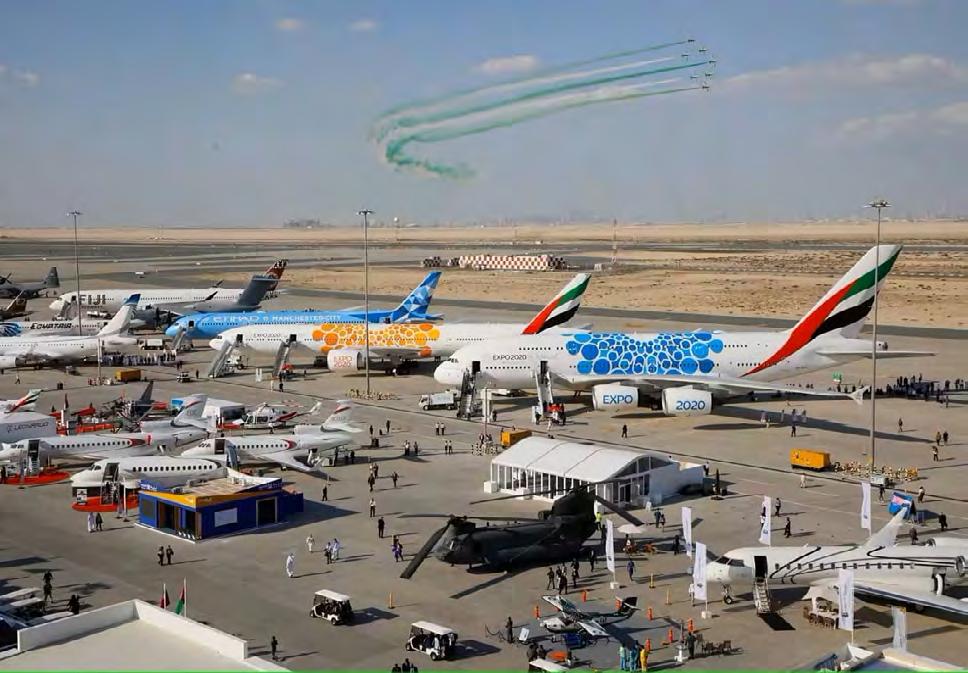
Source: Arabian Business
Finally, the UAE's sustainable aviation leadership serves broader economic diversification goals articulated in the Principles of 50, Operation 300bn, and related long-term strategies. By establishing capabilities in SAF production, alternative propulsion manufacturing, climate technology, and renewable energy, the UAE creates high-value economic activities that complement rather than replace hydrocarbon revenues.
This transformation generates employment across the value chain: from farmers cultivating halophytes, to engineers designing eVTOL systems, to scientists advancing carbon capture and hydrogen production.
Export revenues from SAF, hydrogen, carbon credits, and technology services will contribute to national income, demonstrating that climate action and economic prosperity are mutually reinforcing.
Perhaps most importantly, sustainable aviation leadership enhances the UAE's global reputation, attracting talent, tourism, and investment across all sectors. Nations and companies are increasingly considering sustainability performance when making location and partnership decisions; the UAE leadership provides a competitive advantage that extends far beyond aviation.
Technology roadmap 2025–2050
2025–2030
Launch of commercial-scale SAF production
Initial eVTOL operations commence in Dubai and Abu Dhabi
Hydrogen fueling infrastructure introduced at key airports
Major airports achieve carbon neutrality
Comprehensive regulatory frameworks established for SAF certification, eVTOL operations and hydrogen aviation
2030–2040
SAF share reaches 5–10% of total aviation fuel demand
Regional eVTOL networks fully operational across the GCC
Hydrogen-powered aircraft enter regional and short-haul service
Gigatonne-scale carbon capture facilities achieve commercial operation
Synthetic fuel costs converge with fossil jet fuel
2040–2050
SAF and synthetic fuels dominate the global aviation supply
Electric and hydrogen aircraft operate on most short- and medium-haul routes
Over 50% of fuel used on long-haul flights derived from sustainable sources
Net-zero aviation operations achieved across the UAE
The UAE recognised as a global centre for aviation technology and climate innovation
CONCLUSION: A MODEL FOR THE WORLD
The United Arab Emirates has shown that aviation sustainability is not a trade-off between economic growth and environmental responsibility. It is a strategic evolution, one that turns regional advantages into competitive strengths.
What makes the UAE's approach work is its comprehensiveness:
• SAF production from desert-adapted halophytes and municipal waste;
• Support for electric, hybrid, and hydrogen aircraft;
• World-leading airport carbon management;
• Breakthrough technologies in carbon capture and renewable energy;
• And crucially, institutional frameworks that provide the policy certainty investors need to deploy billions in capital.

The UAE’s natural and structural advantages provide a powerful foundation: abundant solar energy delivering the world’s lowest-cost renewable electricity; feedstocks that do not compete with food or water; and a strategic location bridging Europe and Asia. Building on these, the nation has developed institutional and technological expertise — from worldclass aviation operators to coordinated policy and planning — that turn geographic and resource advantages into sustained competitive strengths.
For the wider GCC, the UAE’s leadership creates a knowledge platform that accelerates regional progress. Rather than beginning from scratch, neighbouring countries can build on proven frameworks while specialising in complementary areas — perhaps Saudi Arabia in massivescale hydrogen, the UAE in SAF synthesis and eVTOL networks, Qatar in airport sustainability, and Oman in carbon mineralisation.
Source: Boeing Mediaroom
For global aviation, aiming for net zero by 2050, the UAE offers a working model. It demonstrates that immediate actions, such as SAF blending, can proceed alongside longer-term innovations in hydrogen and synthetic fuels. It shows how government policy, private capital and technology can align effectively — and that even regions without traditional agricultural resources can lead through innovation adapted to local conditions.
The journey from COP28 to Dubai Air Show 2025 is just the beginning. Production facilities are under construction, aircraft are in testing, infrastructure is being deployed, and partnerships are deepening. Together, these create the momentum and credibility needed for long-term progress. The UAE’s pathway to net-zero aviation by 2050 is ambitious yet achievable, grounded in tangible achievements rather than promises alone.
The message is clear:

Source: Emirates
Sustainable aviation is no longer a distant aspiration but a present reality. It is not a barrier to growth but its next engine. And it is not confined to any one geography – the Gulf is helping to build the world’s sustainable aviation future.
The future of aviation will be sustainable, and that future is being built in the UAE.
GLOSSARY
• ACA (Airport Carbon Accreditation): A global carbon management certification program for airports administered by Airports Council International, with progressive levels from mapping through neutrality to transformation.
• ADNOC (Abu Dhabi National Oil Company): The UAE's state-owned oil and gas company, increasingly involved in carbon capture, hydrogen, and lowercarbon energy initiatives.
• APR-1400: Advanced Power Reactor 1400, a Generation III+ pressurised water nuclear reactor designed by Korea Electric Power Corporation. Four units power the Barakah Nuclear Energy Plant.
• ASTM D7566: The American Society for Testing and Materials specification standard that defines approved production pathways and quality requirements for sustainable aviation fuel.
• Biogenic: Derived from biological sources (plants, animals, microorganisms) rather than fossil sources. Biogenic carbon is considered part of the active carbon cycle rather than adding stored carbon to the atmosphere.
• Blue Hydrogen: Hydrogen produced from natural gas through steam methane reforming, with carbon capture and storage applied to reduce but not eliminate carbon emissions.
• BWRX-300: A 300 MWe small modular reactor design by GE Hitachi Nuclear Energy, representing one of the most advanced SMR technologies globally.
• Carbon Capture, Utilisation and Storage (CCUS): Technologies that capture CO₂ from emission sources or the atmosphere, then either use it as feedstock for products or permanently store it underground in geological formations.
• Carbon Dioxide Removal (CDR): Umbrella term for processes that remove CO₂ from the atmosphere and sequester it long-term, including both natural solutions (reforestation) and technological approaches (DAC, carbon mineralisation).
• Carbon Mineralisation: Process of converting CO₂ into stable carbonate minerals through reaction with certain rock types, providing permanent carbon storage.
• COP28: The 28th Conference of the Parties to the UN Framework Convention on Climate Change, hosted by the UAE in Dubai, November-December 2023.
• CORSIA: Carbon Offsetting and Reduction Scheme for International Aviation, administered by ICAO to address emissions from international flights through offsetting and lowercarbon fuels.
• DEWA (Dubai Electricity and Water Authority): The public utility responsible for electricity and water production and distribution in Dubai, leading major renewable energy projects.
• Direct Air Capture (DAC): Technology that removes CO₂ directly from ambient air using chemical processes, enabling carbon removal regardless of emission source location.
• Drop-in fuel: A fuel that is fully compatible with existing aircraft, engines, and fuel infrastructure without requiring modifications. SAF is designed as a dropin fuel to enable immediate adoption.
• Electrolysis: Process of using electricity to split water (H₂O) into hydrogen and oxygen. When powered by renewables, produces green hydrogen for fuel or chemical synthesis.
• ENEC (Emirates Nuclear Energy Corporation): UAE government entity responsible for the development, construction, and operation of nuclear power plants, including the Barakah facility.
• Estidama: Abu Dhabi's sustainability certification system for buildings and communities, similar to LEED. Zayed International Airport achieved 3 Pearl rating.
• eVTOL: Electric Vertical Takeoff and Landing aircraft. Battery-electric aircraft capable of vertical flight like helicopters but using multiple electric propellers for improved efficiency and reduced noise.
• FAA Part 135: US Federal Aviation Administration regulations governing commercial air taxi and charter operations. Joby Aviation holds this certification.
• Feedstock: Raw material input used to produce a fuel or product. For SAF, feedstocks include waste oils, agricultural residues, algae, municipal waste, and captured CO₂ combined with hydrogen.
• Fischer-Tropsch Synthesis: A chemical process that converts synthesis gas (a mixture of hydrogen and carbon monoxide) into liquid hydrocarbons. Used in several SAF production pathways, including waste-to-fuel processes.
• GCAA (General Civil Aviation Authority): The UAE's federal aviation regulatory body responsible for safety oversight, certification, and rulemaking for civil aviation.
• GCC (Gulf Cooperation Council): Political and economic alliance comprising Saudi Arabia, UAE, Qatar, Kuwait, Oman, and Bahrain, established in 1981.
• Generation III+: Advanced nuclear reactor designs incorporating passive safety systems and improved efficiency.
The Barakah APR-1400 reactors are Generation III+ technology.
• Green Hydrogen: Hydrogen produced through electrolysis using renewable electricity, resulting in zero carbon emissions across the production process.
• Halophytes: Salt-tolerant plants capable of growing in saline conditions, including seawater irrigation, making them suitable for coastal desert cultivation without competing for freshwater or agricultural land.
• Hybrid-Electric Propulsion: Aircraft propulsion combining electric motors (typically for takeoff/landing) with conventional engines or generators (for cruise flight), extending range beyond pure battery-electric systems.
• Hydrogen Fuel Cell: An electrochemical device that converts hydrogen and oxygen into electricity and water, producing zero emissions. Can power electric motors in aircraft.
• IATA (International Air Transport Association): Trade association representing the world's airlines, coordinating industry positions on sustainability and other issues.
• ICAO (International Civil Aviation Organization): United Nations specialised agency establishing international standards and regulations for aviation, including environmental policies.
• Jet A-1: The standard specification for civil aviation turbine fuel used internationally. SAF must meet the same ASTM specifications to be approved for use.
• Lifecycle Emissions: Total greenhouse gas emissions from a fuel or product across its entire lifecycle, from feedstock extraction/cultivation through production, transportation, use, and disposal.
• Masdar: Abu Dhabi's renewable energy company, established in 2006, developing clean energy projects globally with a mandate to reach 100 GW capacity by 2030.
• Municipal Solid Waste (MSW): Everyday garbage and refuse from households and businesses that can be converted to sustainable aviation fuel through gasification and Fischer-Tropsch synthesis.
• Net Zero: Achieving a balance between greenhouse gas emissions produced and emissions removed from the atmosphere, typically targeted for 2050 in aviation sector commitments.
• NextGen FDI: The UAE's initiative to attract foreign direct investment in emerging high-technology sectors, including advanced air mobility and clean energy.
• Power-to-Liquid (PtL): A process that uses renewable electricity to produce hydrogen via electrolysis, which is then combined with captured CO₂ to synthesise liquid hydrocarbon fuels suitable for aviation. Also called e-fuels or synthetic fuels.
• Roads and Transport Authority (RTA): Dubai's integrated transport authority responsible for roads, public transport, traffic, and licensing. Leading eVTOL integration planning.
• Salicornia: A halophyte genus (also called glasswort or pickleweed) that produces oilseeds suitable for conversion to sustainable aviation fuel. Central to the UAE's Seawater Energy and Agriculture System.
• Saline Aquifer: Deep underground formations containing salty water unsuitable for drinking or agriculture, which can be used for permanent CO₂ storage without affecting freshwater resources.
• SAVI (Sustainable and Autonomous Vehicle Industry): Regulatory framework and innovation clusters in Dubai and Abu Dhabi providing testing environments for eVTOLs and autonomous vehicles.
• Small Modular Reactor (SMR): Nextgeneration nuclear reactors with smaller capacity (typically under 300 MWe) than conventional plants, designed for factory fabrication and modular deployment. The BWRX-300 is an example.
• Sustainable Aviation Fuel (SAF): Dropin replacement fuels for conventional jet fuel (Jet A-1) that can reduce lifecycle carbon emissions by up to 80%. SAF can be produced from various feedstocks, including waste oils, agricultural residues, municipal solid waste, and synthetic pathways.
• Tadweer: Abu Dhabi Waste Management Centre, developing the UAE's first municipal solid waste-to-SAF facility in partnership with Etihad Airways.
• Used Cooking Oil (UCO): Waste vegetable oil from food preparation that can be collected and converted into sustainable aviation fuel through transesterification or hydroprocessing.
• Vertiport: Infrastructure facility designed for eVTOL aircraft operations, including landing pads, charging stations, passenger facilities, and air traffic management systems.
• XPRIZE Carbon Removal: A $100 million competition funded by the Musk Foundation to develop gigatonne-scale carbon dioxide removal solutions. Project Hajar won a top award.
Listen to more insights on our podcast
Hosted by SimpliFlying CEO and Founder Shashank Nigam, Sustainability in the Air is the world’s leading sustainable aviation podcast.
Over the past year, aviation guests have included Jan Toschka (Zaffra), Jolanda Stevens (KLM), Tom O'Leary (JetZero), Etosha Cave (Twelve), Grace Cheung (Cathay), Luke Farajallah (Loganair), Nina Marczell (OMV) and Val Miftakhov (ZeroAvia).


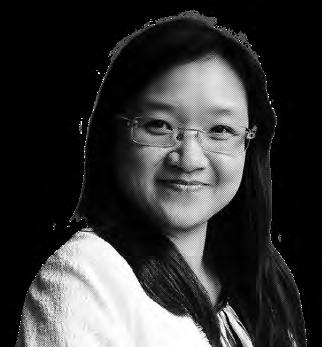
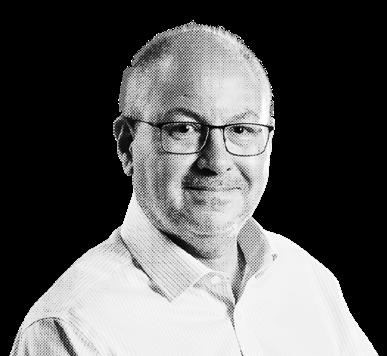





Listen and subscribe to the podcast here:
green.simpliflying.com/podcast
Meanwhile, our Sustainability in the Air website includes weekly articles on sustainable aviation tech startups; reports on subjects as diverse as SAF and eVTOLs; and regular newsletters read by thousands of industry professionals to understand the ever-evolving space of sustainable aviation and the industry’s potential pathways to net zero by 2050.
VOLUME TWO

MEET THE PIONEERS OF SUSTAINABLE AVIATION
Climate change concerns are making the aviation industry turn to sustainable aviation fuel (SAF), electric, and hydrogen-powered aircraft to cut emissions. However, scaling these technologies requires significant innovation. Sustainability in the Air Volume One & Two highlight the journeys of entrepreneurs, executives, and investors who are navigating these challenges and paving the way for the future of aviation.

Learn more at simpliflying.com/sita-vol-two

